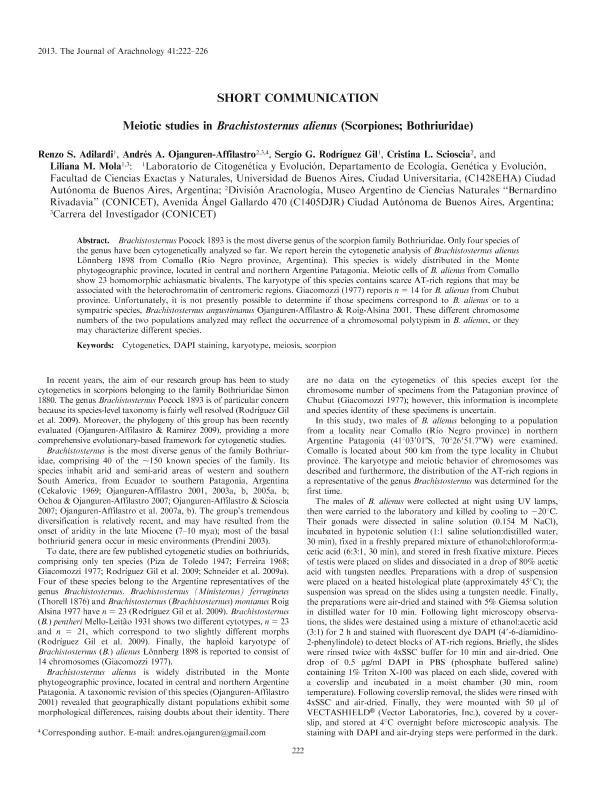Artículo
Meiotic studies in Brachistosternus alienus Lönnberg 1898 (Scorpiones; Bothriuridae)
Adilardi, Renzo Sebastián ; Ojanguren Affilastro, Andres Alejandro
; Ojanguren Affilastro, Andres Alejandro ; Rodríguez Gil, Sergio Gustavo
; Rodríguez Gil, Sergio Gustavo ; Scioscia, Cristina Luisa
; Scioscia, Cristina Luisa ; Mola, Liliana Maria
; Mola, Liliana Maria
 ; Ojanguren Affilastro, Andres Alejandro
; Ojanguren Affilastro, Andres Alejandro ; Rodríguez Gil, Sergio Gustavo
; Rodríguez Gil, Sergio Gustavo ; Scioscia, Cristina Luisa
; Scioscia, Cristina Luisa ; Mola, Liliana Maria
; Mola, Liliana Maria
Fecha de publicación:
06/2013
Editorial:
American Arachnological Society
Revista:
Journal Of Arachnology
ISSN:
0161-8202
Idioma:
Inglés
Tipo de recurso:
Artículo publicado
Clasificación temática:
Resumen
Brachistosternus Pocock 1893 is the most diverse genus of the scorpion family Bothriuridae. Only four species of the genus have been cytogenetically analyzed so far. We report herein the cytogenetic analysis of Brachistosternus alienus Lo ̈nnberg 1898 from Comallo (R ́ıo Negro province, Argentina). This species is widely distributed in the Monte phytogeographic province, located in central and northern Argentine Patagonia. Meiotic cells of B. alienus from Comallo show 23 homomorphic achiasmatic bivalents. The karyotype of this species contains scarce AT-rich regions that may be associated with the heterochromatin of centromeric regions. Giacomozzi (1977) reports n 5 14 for B. alienus from Chubut province. Unfortunately, it is not presently possible to determine if those specimens correspond to B. alienus or to a sympatric species, Brachistosternus angustimanus Ojanguren-Affilastro & Roig-Alsina 2001. These different chromosome numbers of the two populations analyzed may reflect the occurrence of a chromosomal polytypism in B. alienus, or they may characterize different species.
Palabras clave:
Cytogenetics
,
Dapi Staining
,
Karyotype
,
Meiosis
,
Scorpion
Archivos asociados
Licencia
Identificadores
Colecciones
Articulos(MACNBR)
Articulos de MUSEO ARG.DE CS.NAT "BERNARDINO RIVADAVIA"
Articulos de MUSEO ARG.DE CS.NAT "BERNARDINO RIVADAVIA"
Citación
Adilardi, Renzo Sebastián; Ojanguren Affilastro, Andres Alejandro; Rodríguez Gil, Sergio Gustavo; Scioscia, Cristina Luisa; Mola, Liliana Maria; Meiotic studies in Brachistosternus alienus Lönnberg 1898 (Scorpiones; Bothriuridae); American Arachnological Society; Journal Of Arachnology; 41; 2; 6-2013; 222-226
Compartir



